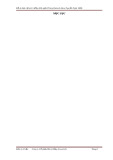
Open Access
Available online http://ccforum.com/content/11/4/R85
Page 1 of 8
(page number not for citation purposes)
Vol 11 No 4
Research
Safety of rFVIIa in hemodynamically unstable polytrauma patients
with traumatic brain injury: post hoc analysis of 30 patients from
a prospective, randomized, placebo-controlled, double-blind
clinical trial
Yoram Kluger1, Bruno Riou2, Rolf Rossaint3, Sandro B Rizoli4, Kenneth David Boffard5, Philip Iau
Tsau Choong6, Brian Warren7 and Michael Tillinger8
1Department of Surgery, Rambam Medical Center, POB 9602, Haifa 31096, Israel
2Departments of Emergency Medicine and Surgery and Anesthesiology and Critical Care, Hôpital Pitié Salpêtrière, Assistance Publique-Hôpitaux de
Paris, Université Pierre et Marie Curie-Paris, Paris, France
3Institute for Anesthesiology, University Clinics, Aachen, Germany
4Sunnybrook Health Sciences Centre, University of Toronto, Toronto, ON, Canada
5Department of Surgery, Johannesburg Hospital, Johannesburg, South Africa
6National University Hospital, Singapore
7Department of Surgery, University of Stellenbosch, Tygerberg, South Africa
8Novo Nordisk A/S, Bagsværd, Denmark
Corresponding author: Yoram Kluger, y_kluger@rambam.health.gov.il
Received: 30 May 2007 Revisions requested: 24 Jul 2007 Accepted: 8 Aug 2007 Published: 8 Aug 2007
Critical Care 2007, 11:R85 (doi:10.1186/cc6092)
This article is online at: http://ccforum.com/content/11/4/R85
© 2007 Kluger et al.; licensee BioMed Central Ltd.
This is an open access article distributed under the terms of the Creative Commons Attribution License (http://creativecommons.org/licenses/by/2.0),
which permits unrestricted use, distribution, and reproduction in any medium, provided the original work is properly cited.
Abstract
Background Trauma is a leading cause of mortality and
morbidity, with traumatic brain injury (TBI) and uncontrolled
hemorrhage responsible for the majority of these deaths.
Recombinant activated factor VIIa (rFVIIa) is being investigated
as an adjunctive hemostatic treatment for bleeding refractory to
conventional replacement therapy in trauma patients. TBI is a
common component of polytrauma injuries. However, the
combination of TBI with polytrauma injuries is associated with
specific risk factors and treatment modalities somewhat
different from those of polytrauma without TBI. Although rFVIIa
treatment may offer added potential benefit for patients with
combined TBI and polytrauma, its safety in this population has
not yet been assessed. We conducted a post hoc sub analysis
of patients with TBI and severe blunt polytrauma enrolled into a
prospective, international, double-blind, randomized, placebo-
controlled study.
Methods A post hoc analysis of study data was performed for
143 patients with severe blunt trauma enrolled in a prospective,
randomized, placebo-controlled study, evaluating the safety and
efficacy of intravenous rFVIIa (200 + 100 + 100 μg/kg) or
placebo, to identify patients with a computed tomography (CT)
diagnosis of TBI. The incidences of ventilator-free days,
intensive care unit-free days, and thromboembolic, serious, and
adverse events within the 30-day study period were assessed in
this cohort.
Results Thirty polytrauma patients (placebo, n = 13; rFVIIa, n =
17) were identified as having TBI on CT. No significant
differences in rates of mortality (placebo, n = 6, 46%, 90%
confidence interval (CI): 22% to 71%; rFVIIa, n = 5, 29%, 90%
CI: 12% to 56%; P = 0.19), in median numbers of intensive care
unit-free days (placebo = 0, rFVIIa = 3; P = 0.26) or ventilator-
free days (placebo = 0, rFVIIa = 10; P = 0.19), or in rates of
thromboembolic adverse events (placebo, 15%, 90% CI: 3% to
51%; rFVIIa, 0%, 90% CI: 0% to 53%; P = 0.18) or serious
adverse events (placebo, 92%, 90% CI: 68% to 98%; rFVIIa,
82%, 90% CI: 60% to 92%; P = 0.61) were observed between
treatment groups.
Conclusion The use of a total dose of 400 (200 + 100 + 100)
μg/kg rFVIIa in this group of hemodynamically unstable
polytrauma patients with TBI was not associated with an
increased risk of mortality or with thromboembolic or adverse
events.
AE = adverse event; AIS = Abbreviated Injury Score; ARDS = acute respiratory distress syndrome; CI = confidence interval; CNS = central nervous
system; CT = computed tomography; FFP = fresh frozen plasma; GCS = Glasgow Coma Scale; ICH = intracerebral hemorrhage; ICP = intracranial
pressure; ICU = intensive care unit; MOF = multiorgan failure; RBC = red blood cell; rFVIIa = recombinant activated factor VII; SAE = serious adverse
event; TBI = traumatic brain injury; TE = thromboembolic; TF = tissue factor.

Critical Care Vol 11 No 4 Kluger et al.
Page 2 of 8
(page number not for citation purposes)
Introduction
Trauma is the leading cause of mortality and severe morbidity
among young adults (15 to 44 years of age), with traumatic
brain injury (TBI) and uncontrolled bleeding responsible for the
majority of these deaths [1-3]. Although some progress has
been made in managing traumatically induced surgical bleed-
ing, treatment of the multifactorial coagulopathic component
of traumatic hemorrhage remains a serious clinical challenge.
Hence, uncontrolled bleeding constitutes a leading cause of
in-hospital mortality despite adequate replacement therapy
with fresh frozen plasma (FFP), platelets, cryoprecipitate, and
fibrinogen [4-7]. Recombinant activated factor VII (rFVIIa) has
been reported as a possible adjunctive, 'off label' treatment for
coagulopathic bleeding that is refractory to conventional
replacement therapy in a growing number of case series and
reports, with several expert-opinion guidelines now published
[8-15].
The results of the first prospective, multicenter, randomized,
placebo-controlled studies of rFVIIa in blunt and penetrating
trauma have been published recently [16]. The incidence of
adverse events (AEs), thromboembolic (TE) events, and seri-
ous adverse events (SAEs) was evenly distributed between
treatment groups, and no safety concerns for the use of rFVIIa
in these patients were raised.
TBI is a common component of the polytrauma injury complex,
especially among patients with blunt trauma [17]. Patients
sustaining combined TBI with polytrauma constitute a special
subpopulation. These patients typically have a poorer progno-
sis [17] and a higher risk for developing coagulopathy and TE
events and require different treatment considerations. For
instance, permissive hypotension is not recommended for TBI
[18].
Theoretically, rFVIIa may be of particular added benefit for
patients with polytrauma and TBI. As adequate cerebral per-
fusion pressure is an important goal of treatment to prevent
secondary brain insult [19,20], arresting bleeding and main-
taining hemodynamic stability are of even greater importance
in hemodynamically unstable patients with TBI. In addition,
rFVIIa may prevent the expansion of traumatic intracerebral
hemorrhage (ICH) in a manner similar to that demonstrated by
the recently published controlled study of spontaneous ICH
patients [21] and as reported by a number of case series
[8,22,23].
Despite these potential advantages and the relative success
and safe profile of rFVIIa described in several case series of
isolated TBI and other central nervous system (CNS) bleed-
ings [8,22-31], there is relatively little clinical experience and
therefore very limited safety evaluation of rFVIIa use in patients
with combined TBI and polytrauma injuries [8]. In addition,
some safety concerns, specifically regarding TE events, have
arisen following the use of rFVIIa in CNS bleeding [21,32,33].
There are also some theoretical concerns of a possible exces-
sive activation of the clotting system with rFVIIa in such inju-
ries, due to the release of tissue factor (TF) in the brain and the
prevalence of consumption coagulopathy or disseminated
intravascular coagulation in brain injuries [34,35].
To assess the safety of rFVIIa in polytrauma with TBI, we have
analyzed the safety data for severely injured blunt-trauma
patients who were included in a prospective, international,
double-blind, randomized, placebo-controlled study of rFVIIa
[16] and who were diagnosed by the investigators by com-
puted tomography (CT) to have had TBI.
Materials and methods
The methods of the placebo-controlled study have been
reported previously [16]. In brief, patients were evaluated for
inclusion in the trial on admission to the trauma center. Inclu-
sion criteria included receipt of 6 units of red blood cells
(RBCs) within a 4-hour period and known age of between 16
(or legally of age, according to local law) and 65 years. Main
exclusion criteria were cardiac arrest prehospital or in the
emergency or operating room prior to trial drug administration;
gunshot wound to the head; base deficit of greater than 15
mEq/l or severe acidosis with pH of less than 7.00; transfusion
of 8 or more units of RBCs prior to arrival at the trauma center;
injury sustained greater than or equal to 12 hours before ran-
domization; and severe TBI, defined as a Glasgow Coma
Scale (GCS) score of less than or equal to 8, unless in the
presence of a normal head CT scan. The protocol for the pla-
cebo-controlled study was approved by the ethics committee
of each participating institution, and the trial was conducted
according to Good Clinical Practice standards, with appropri-
ate informed consent, as described previously [16].
Eligible patients were randomly assigned to treatment groups
after receiving 6 units of RBCs within a 4-hour period. Treat-
ment arms were either three intravenous injections of rFVIIa
(200, 100, and 100 μg/kg; NovoSeven®; Novo Nordisk A/S,
Bagsværd, Denmark) or three placebo injections. The first
dose of study drug was administered immediately after trans-
fusion of the eighth unit of RBCs given that the patient, in the
opinion of the attending physician, would require additional
transfusions. The second and third doses followed 1 and 3
hours after the first dose, respectively. Study drug was admin-
istered in addition to standard treatment for injuries and bleed-
ing at the participating hospitals.
Traumatic brain injury post hoc subanalysis
In accordance with protocol inclusion criteria, all patients were
hemodynamically unstable (6 units of RBCs within 4 hours of
admission and ongoing bleeding as determined by the investi-
gator). Treatment priorities in such hemodynamically unstable
patients preclude any clinical or ethical possibility of perform-
ing a prospective baseline head CT, which would be required

Available online http://ccforum.com/content/11/4/R85
Page 3 of 8
(page number not for citation purposes)
for an accurate diagnosis and severity assessment of the head
injury in the majority of these patients.
Therefore, to identify patients with a TBI component of their
injury, we were obliged to perform a post hoc subanalysis. This
analysis was based on CT imaging findings, which were
obtained at the investigator's clinical judgment, after enroll-
ment, and only upon reaching clinical stabilization of the
patients.
The severity of TBI was prospectively assessed by both the
GCS and Abbreviated Injury Score (AIS). However, for the
purposes of identifying patients with TBI for this analysis, only
the AIS (as reported by investigators) was used for screening.
This is because the AIS is based on the objective anatomical
findings on CT imaging and also because the accuracy of the
GCS assessment is limited in ventilated or pharmacologically
paralyzed patients, such as those enrolled into this analysis.
All data for patients with AIS of any severity (1 to 6) in the ana-
tomical region of the head (region 1) were reviewed manually
by a physician who was blinded to the therapy arm. Patients
who met the criteria of descriptors of injury that fit accepted
definitions of TBI were included in this analysis. The inci-
dences of AEs, SAEs, TE events, ventilator-free days, and
intensive care unit (ICU)-free days were evaluated over the
study period of 30 days.
Statistical analyses
Data are expressed as mean ± standard deviation, medians
[minimum-maximum], and percentages with their 90% confi-
dence interval (CI). Comparison of two means was performed
using the Student t test, comparison of two medians using the
Wilcoxon test, and comparison of two proportions using the
Fisher exact test. All P values were two-tailed, and a P value of
less than 0.05 was considered significant.
Results
Of the 143 blunt polytrauma patients randomly assigned into
the prospective trial [16], a total of 30 (21%) patients were
identified as having a TBI component. The main TBI diagnoses
on CT were subarachnoid hemorrhage, occurring in 10 of 30
(33%) patients; intracerebral contusion or hematoma, occur-
ring in 10 of 30 (33%) patients; and other types of TBI (two
subdural hemorrhages, two depressed fractures, one diffuse
axonal injury, one ischemia, one edema, one intraventricular
hemorrhage, and two unspecified), occurring in the remaining
10 of 30 (33%) patients with TBI. Thirteen (43%) of the
patients with TBI were in the placebo group, and 17 (57%)
were in the rFVIIa group. Despite the fact that enrollment was
based on the severity of bleeding caused by the systemic pol-
ytrauma rather than the TBI component of the injury, baseline
characteristics and severity of TBI were similar for patients in
the placebo and treatment groups (Table 1).
Safety assessment
Mortality
The results of the safety assessment are presented in Table 2.
A total of 11 of 30 (37%) patients died during the 30-day fol-
low-up: 6 of 13 (46%; 90% CI, 22% to 71%) in the placebo
group and 5 of 17 (29%; 90% CI, 12% to 56%) in the rFVIIa
group (P = 0.19) (Table 2).
Early mortality (less than or equal to 48 hours) was encoun-
tered by 3 of 13 (23%; 90% CI, 7% to 56%) patients in the
placebo group: one death from cardiac contusion within 3
hours of hospital admission, one death from hypovolemic
shock within 5 hours of hospital admission, and one death
from TBI (right middle cerebral artery infarct) within 44 hours
after hospital admission.
Similarly, there were 2 of 17 (12%; 90% CI, 2% to 43%) early
mortalities reported in the rFVIIa group. Both of these deaths
Table 1
Patient characteristics: baseline parameters
Placebo (n = 13) rFVIIa (n = 17)
Female, number (percentage) 5 (38) 7 (41)
Age, years 32.6 ± 16.8 33.5 ± 13.7
Injury Severity Score 36.8 ± 12.8 38.7 ± 13.7
Abbreviated Injury Score head (region 1) 3 [3-5] 3 [3-5]
Mean arterial pressure, mm Hg 76 ± 22 71 ± 18 (n = 16)
Body temperature, °C 35.1 ± 1.3 (n = 8) 34.3 ± 1.8 (n = 9)
pH 7.24 ± 0.12 (n = 11) 7.22 ± 0.10 (n = 15)
Baseline refers to predosing. All data are presented as number of patients (percentage) or mean (± standard deviation shown in most cases) or
median [minimum-maximum shown], and n is indicated in cases in which there are missing values. rFVIIa, recombinant activated factor VII.

Critical Care Vol 11 No 4 Kluger et al.
Page 4 of 8
(page number not for citation purposes)
occurred as a result of hypovolemic shock: one within 5 hours
of hospital admission and the other within 17 hours of hospi-
talization. Therefore, there was no difference in the rate of early
mortality between placebo- and rFVIIa-treated patients (P =
0.63).
Late mortality (within 30 days) was encountered by 3 of 13
(23%; 90% CI, 7% to 56%) patients in the placebo group:
one from brain death 3 days (54 hours) after hospital admis-
sion, one from multiorgan failure (MOF) 5 days (125 hours)
after hospital admission, and one from pulmonary embolism,
confirmed by postmortem, 5 days (114 hours) after
hospitalization.
In the rFVIIa group, there were 3 of 17 (18%; 90% CI, 5% to
47%) late mortalities, one of which was from persistent ele-
vated intracranial pressure (ICP) despite two surgical interven-
tions and extensive medical and pharmacological treatment.
The patient died 8 days (188 hours) after admission. Another
death was caused by MOF, confirmed by postmortem, within
3 days (58 hours) of hospital admission. The third death was
caused by sepsis 11 days (270 hours) after hospitalization.
There was no difference in the rate of late deaths between pla-
cebo- and rFVIIa-treated patients (P = 1.00).
Serious adverse events and thromboembolic events
There were no significant differences in the incidence of
reported SAEs and TE events for the two groups. SAEs were
reported for 12 patients (92%) who had received placebo and
14 patients (82%) who had received rFVIIa (P = 0.61) (Table
2). Of these SAEs, there were 2 of 13 (15%; 90% CI, 3% to
51%) TE SAEs reported in the placebo group; one was a fatal
pulmonary embolism and the other a subclavian vein thrombo-
sis that was resolved with treatment. There were no TE AEs
(0%; 90% CI, 0% to 53%) in the rFVIIa group (P = 0.18).
There were no significant differences in the number of patients
who experienced MOF and acute respiratory distress syn-
drome (ARDS) or in the number of ICU-free days or ventilator-
free days (Table 2).
Discussion
Clinical use of recombinant activated factor VIIa
General
rFVIIa (NovoSeven®; Novo Nordisk A/S) is indicated for the
treatment of bleeding episodes and for the prevention of
bleeding during surgery or invasive procedures in patients with
congenital hemophilia A and B with inhibitors to coagulation
factors VIII (FVIII) or IX (FIX) or in those expected to have a high
anamnestic response to FVIII or FIX, acquired hemophilia, con-
Table 2
Comparison of safety parameters between placebo- and rFVIIa-treated patients
Placebo rFVIIa P value
Number of patients 13 17 -
Adverse events 12 (92; 68–98) 15 (88; 67–96) 1
Patients 31 44
Events
Serious adverse events
Patients 12 (92; 68–98) 14 (82; 60–92) 0.61
Events 26 33
Thromboembolic serious adverse eventsa
Patients 2 (15; 3–51) 0 (0; 0–53) 0.18
Events 2 0
Mortality (total) 6 (46; 22–71) 5 (29; 12–56) 0.19
Early mortality (≤48 hours) 3 (23; 7–56) 2 (12; 2–43) 0.63
Late mortality (>48 hours to 30 days) 3 (23; 7–56) 3 (18; 5–47) 1
Multiorgan failure 2 (15; 3–51) 3 (18; 5–47) 1
Acute respiratory distress syndrome 2 (15; 3–51) 2 (12; 2–43) 1
Intensive care unit-free daysb0 [0–21] 3 [0–23] 0.26
Ventilator-free daysb0 [0–25] 10 [0–24] 0.19
Data are presented as number of patients (percentage; 90% confidence interval) or median [minimum-maximum]. aBoth thromboembolic serious
adverse events were part of the entire cohort of 12 serious adverse events reported for the placebo group. bP values apply to the two-sided
Wilcoxon rank test. All other P values apply to the two-sided Fisher exact tests. rFVIIa, recombinant activated factor VII.

Available online http://ccforum.com/content/11/4/R85
Page 5 of 8
(page number not for citation purposes)
genital FVII deficiency, and in Europe for Glanzmann's throm-
basthenia refractory to platelet transfusions.
Since the first report of the successful use of rFVIIa in an Israeli
patient with a penetrating gunshot wound to the vena cava in
1999 [36], there has been an increasing number of case
reports and series describing the 'off label' treatment of coag-
ulopathic bleeding in a wide array of clinical scenarios. These
publications have described hematological indications [37],
reversal of anticoagulation [38,39], as well as bleeds in criti-
cally ill patients, such as in civilian and military trauma [8-
10,40], cardiac surgery [41], postpartum hemorrhage [42,43],
and other clinical situations in which impaired hemostasis has
posed a serious, and often life-threatening, therapeutic chal-
lenge. A thorough review of these uses is beyond the scope of
this paper and can be found elsewhere [44,45].
Central nervous system bleeds
The clinical use of rFVIIa in CNS bleeds has also been pub-
lished. Bleeding in these patients resulted from a variety of eti-
ologies, including TBI, spontaneous ICH, neurosurgery,
anticoagulation medications, and underlying hematological
disease [8,21-31,46].
Traumatic brain injury
Dutton and colleagues [8] described a series of 81 coagulo-
pathic trauma patients treated with rFVIIa. Of these, 20
received rFVIIa for treatment of coagulopathy related to TBI.
Six of these patients had additional polytrauma. The outcome
of these patients was poor and 15 of 20 patients died. The
authors attributed this high mortality rate to the severity of
brain injury. None of the 81 trauma patients in this series had
any clinical indication of TE events.
Zaaroor and Bar-Lavie [23] reported the first series of five
patients with TBI with a hemorrhagic component in whom
rFVIIa treatment was reported to be effective in controlling the
evolution of intracerebral brain contusion and bleeding. Four
patients presented with a penetrating head injury, and one
with a blunt head injury. In all patients, hemorrhagic brain con-
tusion was encountered with the potential for expansion that
could have led to severe neurological deterioration as deemed
by the authors. Limited expansion was noted subsequent to
treatment with 90 to 100 μg/kg rFVIIa, and no TE AEs were
attributed to administration of this agent.
Morenski and colleagues [24] described the use of 90 μg/kg
rFVIIa in three pediatric TBI cases in which coagulopathy pre-
vented the insertion of an ICP monitor, which was deemed cru-
cial for guiding optimal treatment. The youngest patient was 5
weeks old. In all three patients, coagulopathy persisted
despite treatment with FFP. Administration of rFVIIa corrected
the coagulopathy, allowing for the successful insertion of the
ICP monitor with no TE events observed.
Safety of recombinant activated factor VIIa
Overall, rFVIIa is considered to have a favorable safety profile
in hemophilia and in critical bleedings across a broad array of
clinical scenarios [47-51]. However, because of its prohemo-
static activities, concerns persist over the risk for TE events
during its clinical use [52].
The previously mentioned randomized, controlled studies in
blunt and penetrating trauma [16], which forms the basis for
this analysis, have demonstrated no safety concerns when
using rFVIIa in trauma patients. Thus, TE events occurred in
4% (6 of 138) of the placebo-treated patients as compared
with 4% (6 of 139) of the rFVIIa-treated patients. The inci-
dence of fatal TE events was low and did not differ between
the treatments groups (1% in the placebo group versus 1% in
the rFVIIa group) [16,49].
In a recent review based on 13 different controlled clinical tri-
als in which rFVIIa has been studied in patients with coagulop-
athy secondary to the use of anticoagulant therapy, cirrhosis,
or severe trauma (including a detailed safety profile of the
study by Boffard and colleagues [16] described within this
paper), it was found that there was no significant difference
between placebo-treated and rFVIIa-treated patients with
respect to TE AEs, either in the individual trials or when the
study populations were combined (5.3% (23 of 430) of pla-
cebo-treated patients and 6.0% (45 of 748) of rFVIIa-treated
patients; (P = 0.57) [49].
This safety profile can probably be attributed to the localized
activation of coagulation at the site of injury [49-51]. At phar-
macological doses, rFVIIa induces hemostasis by binding
either to TF or directly to activated platelets, which are the
physiological markers of tissue injury. This initiates a cascade
that results in a thrombin burst and the formation of a stable
fibrin plug [37,53].
Despite this encouraging safety profile, several publications
regarding the use of rFVIIa in CNS bleeding have raised some
safety concerns:
In a recently published controlled study of rFVIIa in spontane-
ous ICH [21], 399 patients received placebo or 40, 80, or 160
μg/kg rFVIIa. A significant reduction in hematoma size, mortal-
ity, and morbidity was observed in the rFVIIa-treated group. TE
AEs, mainly myocardial or cerebral infarction, occurred in 7%
of the rFVIIa-treated patients compared with 2% in the pla-
cebo group (P = 0.12). There were no arterial TE SAEs in the
placebo group; the overall frequency of such events was 5%
among the rFVIIa-treated patients (P = 0.01 by Fisher exact
test). However, TE SAEs that were possibly or probably
related to treatment and that were fatal or disabling occurred
equally (2%) in the rFVIIa-treated group and the placebo
group. An ongoing phase III study is likely to provide a better
evaluation of safety in this patient population.

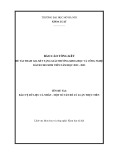
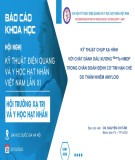

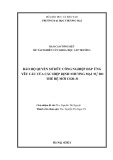
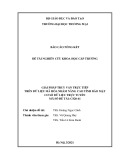
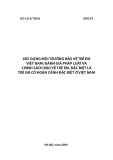

![Vaccine và ứng dụng: Bài tiểu luận [chuẩn SEO]](https://cdn.tailieu.vn/images/document/thumbnail/2016/20160519/3008140018/135x160/652005293.jpg)
